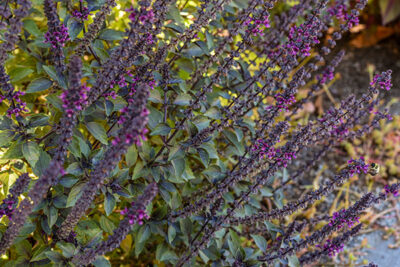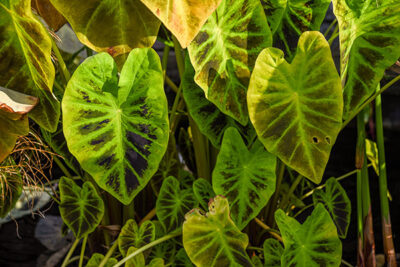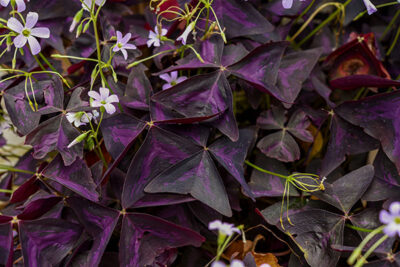By Ally Chua, New England Botanic Garden staff
September 2024

Dark purple basil (Ocimum basilicum ‘Wild Magic,’) with its purple rims and flowers, adds an interesting and fragrant addition to a goth garden.
Gardens are often synonymous with the color green and lush foliage. However, it doesn’t mean that plant lovers cannot also embrace their darker side. As NPR observed, the goth gardens trend has been spiking recently, with some home gardens going viral on social media for their dark, romantic aesthetic. With the popularity of TV programs like “Wednesday”, a spinoff of The Addams Family, photos of gardens with dark purple foliage and deep red flowers, set amidst moody sculptures, have made the rounds on the Internet.
The Victorian era seems to be a common inspiration for such gardens, given the Victorians’ fascination with death and acceptance that it was part of everyday life. The period brings to mind melancholic gardens with moss houses, winding paths, and old statuaries, augmented by Gothic architecture features like stone archways and stained-glass windows. Goth gardens often feature elements of death or decay, which could be in the form of memorials to loved ones, crumbling sculptures, and worn derelict-looking structures. And, of course, plants with dark, dark foliage.
While there are commonalities, there isn’t a universal definition for what makes a garden ‘goth’, so gardeners have free rein to apply their personalities and preferences when building such gardens. But how does one begin the dark, haunting garden of their dreams? It begins the same way as any other garden: by asking yourself how the garden will be used.
You will need to consider how much space you have and how it is structured, such as whether there are obstructions or unwieldy layouts to accommodate. Other considerations include the amount of humidity and light the garden space receives and whether children or pets access the space. For example, you may desire a particular plant – such as the Alocasia ‘Black Velvet’ (Alocasia reginula ‘Black Velvet’) with its dramatic dark foliage, but the plant is poisonous to pets and would not be suitable if you have a nosey Mr. Fluffles. Once this basic assessment is laid out, you will be ready to decide what plants to get for your garden space.
You do not always need a huge outdoor space. With a careful selection of houseplants and space planning, it is possible to have a goth garden indoors with plants such as Colocasia esculenta var. antiquorum ‘Black Beauty’, commonly called ‘Black Beauty Elephant Ear’.

The elephant-eared Imperial Taro (Colocasia esculenta var. antiquorum ‘Illustris,’) which has all-black leaves contrasted against green veins.
Dark as Night
Many annuals including lilies, dahlias, and tulips have dark purple or dark red variations, such as the dahlia variety ‘Black Narcissus’ and tulip variety ‘Queen of Night’, both of which have petals of dark luscious purples. Those are not the only types of plants to choose from. There are also perennials with unusual foliage, such as the false shamrock (Oxalis triangularis), Ophiopogon planiscapus ‘Black Dragon,’ or Imperial Taro (Colocasia esculenta var. antiquorum ‘Illustris’). These offer height and color variation with flowering annuals. Dark-colored varieties of vegetables such as carrots, basil, and pumpkins will not just add gothic flair to your garden but offer ghoulish deliciousness after harvesting.
Add Contrast
The next consideration may seem a contradictory one, but one should look beyond dark-colored plants. Shades of black may fit the goth ideal, but a garden full of dark plants may not show up well, especially against dark mulch. Instead, you can consider contrasting darker plants with those with lighter foliage. The Hosta ‘White Feather’ has pale, ethereal leaves that darken to white-green when they are mature. Another perennial to check out will be Pulmonaria ‘Moonshine,’ which has silver-white speckled leaves.
Another approach to goth gardening is to work with your existing garden and add the darker goth pallet to it. For example, adding darker plantings like Coral Bells ‘Black Pearl’ (Heuchera Primo ‘Black Pearl’) to the acid greens of hostas brings out the best in both.
The Strange but Beautiful
Finally, consider adding texture with spiky plants or carnivorous plants for a spookier garden. If you think about it, insect-eating plants fits perfectly with the concept of death and decay. Besides being on theme, many carnivorous plants have purple-red colored varieties, which fits with a goth color scheme as well. Interested gardeners could check out plants like the ‘Red Dragon’ Venus flytrap (Dionaea muscipula ‘Akai Ryu’) and pitcher plant hybrid ‘Conversation Piece’ (Sarracenia x moorei ‘Conversation Piece’).
There are many possibilities when it comes to designing the goth garden of your dreams (or nightmares), and this post touches on just a few. If you are interested in learning more, New England Botanic Garden has many resources and programs that you can delve into. Visit the other sections of our website for more information.
Other References:
About the Author
Ally Chua was a temporary Garden staff member during the summer of 2024. She was part of the pioneer Communications team in Gardens by the Bay (Singapore). For over eight years, she publicized iconic flower exhibitions, events and festivals at the Gardens. She moved to Boston in 2023 to pursue a MA in Public Relations (Emerson College) and has been here ever since. Ally is a published writer in her spare time.

